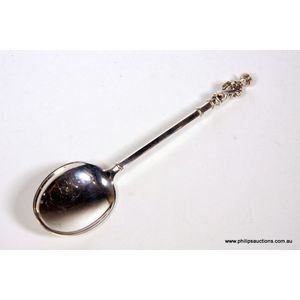1901 Sterling Silver Apostle Spoon by Haseler Brothers
You must be a subscriber, and be logged in to view price and dealer details.
Subscribe Now to view actual auction price for this item
When you subscribe, you have the option of setting the currency in which to display prices to $Au, $US, $NZ or Stg.
- Hallmarks - A mark stamped on articles of precious metals in Britain, since the 14th century, certifying their purity. It derives its name from the Guild Hall of the Goldsmiths' Company, who recieved its Charter in 1327 giving it the power to assay (test the purity) and mark articles of gold and silver.
The hallmark will consist of several marks, including the:
- silver standard mark, indicating the purity of the metal. Sterling silver is .925 pure silver.
- the city mark indicating the city in which it was assayed eg London, Birmingham, York etc.
- the date mark, usually a letter of the alphabet in a particular font and case,
- a duty mark, indicating whether duty had been paid to the crown, and only in use from 1784 to 1890
The piece may include an additional mark, the maker's mark, although not forming part of the hallmark, will be located in the vicinity of the hallmarks.
Sometimes silver plated items will bear faux hallmarks, often confusing those not familiar with silver markings. - Marrow Spoon - A spoon with a long handle and a narrow scoop shaped bowl, used to scoop and eat marrow from the hollow centre of roasted bones. Some marrow scoops are double ended with a different shaped bowl at each end.
- Rat Tail - A spoon with a flattened handle, tapering from the narrow section at the bowl, and wider as the top of the handle, that when viewed from above is of a similiar shape to a rat's tail. Also known as the Hanoverian pattern, as its manufacture spanned the reigns of George I, II and III (part) of the House of Hanover dynasty. The rat tail pattern was the forerunner to the Old English pattern.
- Sterling Silver - Sterling silver is a mixture of 92.5% pure silver and 7.5% of another metal, usually copper. Fine silver is 99.9% pure silver, and is relatively soft and the addition of the very small amount of copper gives the metal enough strength and hardness to be worked into jewellery, decorative and household objects.
- Finial - An architectural decoration, found on the upper parts of of an object. On furniture they are usually found on pediments, canopies and shelf supports. On smaller ceramic or silver items, such as spoons, they may decorate the top of the item itself, or the lid or cover where they provide a useful handle for removal.
Finials have a variety of shapes and forms. They may be urn-shaped, baluster shaped round or spiral, but usually taper into an upper point. Many real life shapes may also be used as finials, such as pineapples, berries, pinecones, buds, lotus and acorns. Sometimes animals such as a lion are depicted, or fish and dolphins.
This item has been included into following indexes:
- silver cutlery / flatware, patterns - rat tail rats tail rattail pattern 57
- spoons, silver
Visually similar items

Mid Georgian sterling silver table spoon, London hallmarks rubbed, 22.7 cm long, 76 grams

A late Georgian Scottish sterling silver ladle, 1835 Edinburgh, with marker's mark for James McKay, a fiddle pattern ladle with an oval bowl; crisply hallmarked underside, silver weight 209gr, length 31 cm

A Georg Jensen sterling silver acorn pattern toddy ladle, post 1945, acorn or Konge, originally designed in 1915 by Johan Rodhe, the elegant ladle with a tapering fluted handle and pierced finial, the bowl with a double pourer; with maker's stamp and stand

A Russian. 875 silver gilt Teapspoon, 19th century Moscow, assayer H.A, rubbed date mark, zolotniki 84 and unknown master's mark for possibly 1831-40 period, the traditionally shaped spoon with a tapering bowl and an engraved floral and patterned design to
